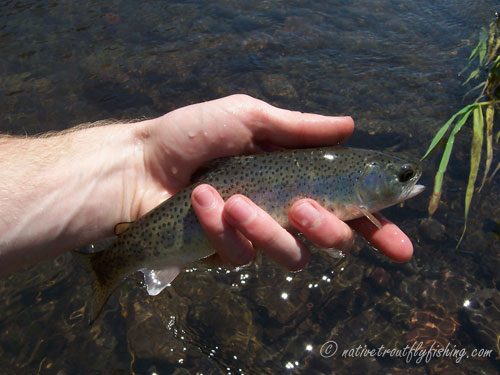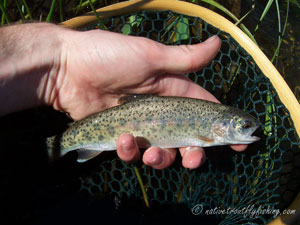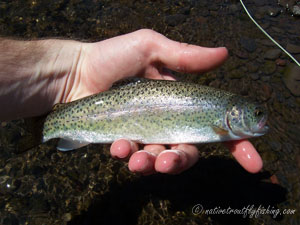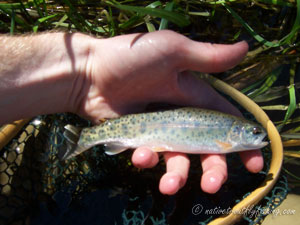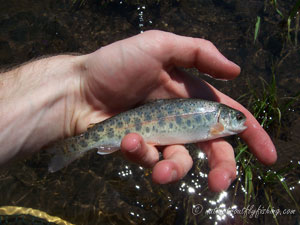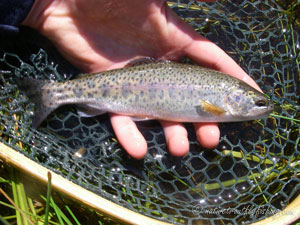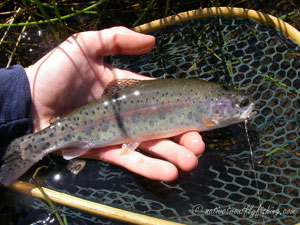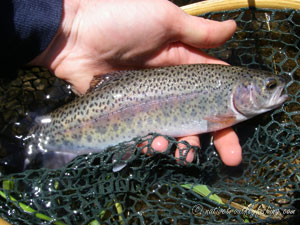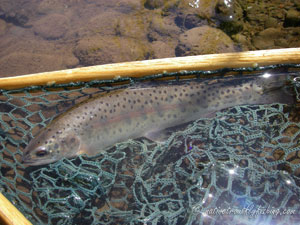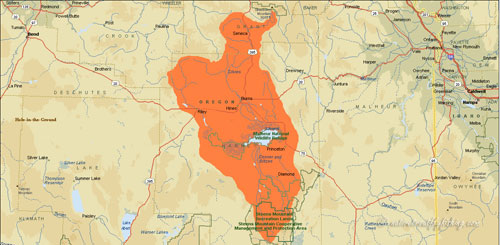Harney-Malheur Basin Redband
Oncorhynchus mykiss gairdneri
A Harney-Malheur Basin Redband from an eastern Oregon desert stream
Introduction
The Harney-Malheur Basin Redband Trout are native to streams flowing into the Harney and Malheur Lake basins in Eastern Oregon. These fish have been considered to be part of the subspecies Oncorhynchus mykiss newberrii (Behnke 2002), although genetics indicate that they are more closely related to Columbia Basin Redband Trout than other Great Basin Redband populations (Currens et al. 2009) and should be consider part of the Oncorhynchus mykiss gairdneri subspecies. It is believed that these the Harney-Malheur Redbands were isolated when a lava flow disconnected the basin from the Malheur River drainage approximately 18,000 years ago (Behnke 1992, Behnke 2007).
Life History Information
Harney-Malheur Basin Redband Trout exhibit many life history traits common to other subspecies of Rainbow Trout. These Redbands exhibit stream-resident, fluvial and adfluvial life history patterns. As with much of the desert redband habitat, the streams in the Harney-Malheur basin are generally small, unstable and often lack connections with each other. Due to this most of the streams in the basin have fish exhibiting a stream-resident life history type. Streams in the basin also typically have higher daily maximum temperatures than those experienced by other Rainbow Trout population and as such maximum feeding and growth rates for stream resident populations occur at higher temperatures than observed with any other forms of Rainbow Trout (Rodnick et al. 2004).
The Donner und Blitzen River is the only drainage within the Harney-Malheur Basin that maintains suitable conditions for trout to survive in throughout its entire length and as such its' fish are able to exhibit migratory life history strategies (ODFW 2005). While stream resident populations are primarily drift feeders, depending on aquatic and terrestrial invertebrates, migratory fish become piscivorous, feeding on minnows that are abundant in the lower Donner und Blitzen River and Malheur Lake. These piscivorous fish can reach sizes of over 22 inches (550 mm) and appear to have a maximum age of five years old (Anderson et al. 2011). Migratory fish a generally observed moving into the lower portion of the river in the fall and overwinter there before migrating upstream in the spring of the next year (Anderson et al. 2011). The adfluvial portion of this life history, in which fish travel to Malheur Lake is only possible when the lake level is high enough and during drought years the lake may desiccate to the point at which the habitat is not suitable for trout. The flexibility to take advantage of increased foraging opportunities presented by the lake when conditions allow has been important adaptation to insuring the survival of these fish in such a harsh environment (Behnke 2002). Immature fluvial fish in the Donner und Blitzen River, are known to migrate throughout the basin during the warmer months of 0the year to locate thermal refuges (Anderson et al. 2011). Mature fish exhibiting migratory life histories migrate up to 56.5 miles (91 km) into the upper river and its tributaries to spawn between March and June, with the peak migration timing occurring just after spring runoff begins to subside in April and May (Anderson 2007).
Status
In 1997 there was a petition to list the Redbands of the desert basins of Oregon including the Harney-Malheur Redband under the Endangered Species Act (ESA) (USFWS 1997). Although it was found that these fish were not warranted to be listed under the ESA, the Oregon Department of Fish and Wildlife followed up with a survey of the status of these fish. Of the ten populations identified in the survey, two appeared to be severely depressed, and only the Donner und Blitzen drainage was not suffering from low productivity (ODFW 2005). The main threats to these fish have come from habitat degradation and the introduction of non-native fish. Throughout their native range habitat has been altered by the removal of riparian vegetation, presence of man-made barriers to migration and reduced stream flows. Diversion dams in the Donner und Blitzen watershed are thought to also delay spawning migrations, with fish from the lower river, which must pass more diversion dams arrive on the spawning grounds an average of 12 days later than fish from the middle river (Anderson et al. 2011). Up until 1993, rainbow trout were stocked in streams throughout the Harney-Malheur basin and Redbands in the Silvies River and one other population appear to be slightly hybridized with hatchery origin rainbow trout (ODFW 2005). Silver Creek, which historically drained to Harney Laker has an extensive history of hatchery plants and has a significant level of hybridization with hatchery Rainbow Trout (Behnke 1992, 2007, DeHaan et al. 2015). Fortunately, this is not the norm and hybridization with hatchery Rainbow Trout does not appear to be a significant issue across most of the Harney-Malheur Basin Redband populations (DeHaan et al. 2015).
Description
Harney-Malheur Basin Redband Trout are similar in appearance to Columbia Basin Redband Trout. The coloration of these fish is olive on the back and transitions to greenish yellow across the body. They have a pink to brick red stripe along their lateral line, and the same coloration on their gill plates. The spotting pattern consists of small round to irregular shaped spots profusely distributed both above and below the lateral line as well as on the caudal and dorsal fins. The caudal fin is forked, and the dorsal, anal, and pelvic fins are tipped with white.
Stream Resident Form
Click on images to view a larger picture
Native Range
A map of the native range of the Harney-Malheur Basin redband trout. Data Sources: Behnke (2002) and ODFW (2005).
References
Anderson, M. 2007. Migratory life history of redband trout in the Donner und Blitzen River. Oregon Department of Fish and Wildlife, Salem, OR.
Anderson, M.C. G. Giannico and S. Jacobs. 2011. Seasonal migrations of adult and sub-adult redband trout in a high desert basin of Eastern Oregon, USA. Ecology of Freshwater Fish 20(3): 409-420.
Behnke, R. J. 1992. Native trout of western North America. American Fisheries Society Monograph 6. American Fisheries Society, Bethesda, Maryland.
Behnke, R. 2002. Trout and Salmon of North America. Chanticleer Press, New York.
Behnke, R.J. 2007. Redband trout of the Northern Great Basin. Pages 1–9 in R. K. Schroeder and J.D. Hall, editors. Redband trout: resilience and challenge in a changing landscape. Oregon Chapter, American Fisheries Society, Corvallis.
Currens, K.P., C.B. Schreck and H.W. Li. 2009. Evolutionary ecology of redband trout. Transactions of the American Fisheries Society 138: 797–817.ODFW. 2005. Oregon native fish status report. Oregon Dept. of Fish and Wildlife, Salem, OR.
DeHaan, P., J. Von Bargen, M. Meeuwig and S. Clements. 2015. Great Basin redband trout genetic status assessment. United States Fish and Wildlife Service. Longview, Washington.
ODFW. 2005. Oregon native fish status report. Oregon Dept. of Fish and Wildlife, Salem, Oregon.
Rodnick, K.J., Gamperl, A.K., Lizars, K.R., Bennett, M.T., Rausch, R.N., and Keeley, E.R. 2004. Thermal tolerance and metabolic physiology among redband trout populations in south-eastern Oregon. Journal of Fish Biology 64: 310-335.
U.S. Fish and Wildlife Service (USFWS). 1997. A petition for rules to list great basin redband trout (Oncorhynchus mykiss ssp) as threatened or endangered under the Endangered Species Act. Oregon Natural Desert Association, Portland, OR.
Contact
Feel free to contact me if you have any questions or comments
Harney-Maleur Basin Redband Trout Links
My Harney-Malheur Basin Redband Trips
Oregon Department of Fish and Wildlife - Redband Trout
Donner und Blitzen Wild and Scenic River - Bureau of Land Management
Western Native Trout Initiative - Redband Trout
Native Trout Links
Truchas Mexicanas' - Native Trout of Mexico
Balkan Trout Restoration Group
Trout and Seasons of the Mountain Village - About Japanese Trout
Western Native Trout Challenge
California Heritage Trout Challenge
Fly Fishing Blogs
Dave B's Blog: Fly Fishing for Native Trout
The Search for Native Salmonids
Conservation Links
Western Native Trout Initiative
Fly Fishing Links
Fishing Art Links
Americanfishes.com - Joseph R. Tomelleri
